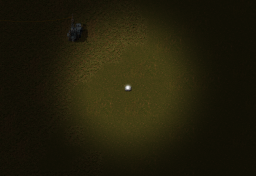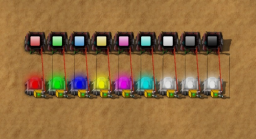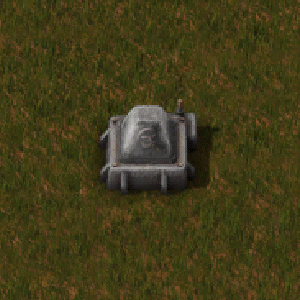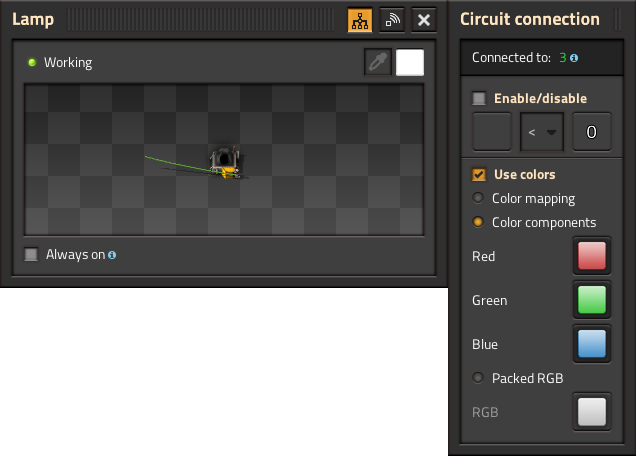Lamp: Difference between revisions
I hope this isn't overdoing it. ={ |
m dot |
||
| (9 intermediate revisions by 5 users not shown) | |||
| Line 3: | Line 3: | ||
[[File:lamp-example-1.png|thumb|Radius of a single lamp.|256px]] | [[File:lamp-example-1.png|thumb|Radius of a single lamp.|256px]] | ||
[[File:Lamp colors.png|thumb| | [[File:Lamp colors.png|thumb|Many lamp colors.|256px]] | ||
The lamp is a basic electric device providing light to a medium area (10 tile radius) at night. It can be used to increase visibility in a factory, so [[nightvision]] is not needed. | The '''lamp''' is a basic electric device providing light to a medium area (10 tile radius) at night. It can be used to increase visibility in a factory, so [[nightvision]] is not needed. Lamps can be toggled to always be on, regardless of time of day. | ||
== Color == | == Color == | ||
Lamp colors can be changed. | Lamp colors can be changed by customizing the color with RGB values. This can also be done by sending a color signal to the lamp. When the condition inside the lamp passes, instead of lighting up white, it will use that color. This can be used to create colored displays, or indicate status. If more than one color signal is received, precedence is given to them in the order below (i.e. if red and green are received, the lamp will light red). As of now, attempting to use grey or black signals will just dim the lamp's light range, making those signal colors somewhat useless. | ||
Colored lamps illuminate only to a 1.5 tile radius. | When attached to a circuit, and the "Use colors" option is selected, the lamp can be configured to use color mapping, which controls the lamp's output based on color signals passed to it, or color components can be used, which are specified by red, blue and green signals separately. A packed RGB value can also be used, which uses an eight digit hex color for the color. The lamp can appear as black when the color components option is used while being turned off. | ||
<!-- Colored lamps illuminate only to a 1.5 tile radius. | |||
Available colors: | Available colors: | ||
* {{Color|ff6666}} <span style="color:#FF7777">Red</span> | |||
* {{Color|55dd55}} <span style="color:#55dd55">Green</span> | |||
* {{Color|8888FF}} <span style="color:#aaaaFF">Blue</span> | |||
* {{Color|FFFF55}} <span style="color:#FFFF55">Yellow</span> | |||
* {{Color|FF77FF}} <span style="color:#FF77FF">Magenta</span> | |||
* {{Color|77FFFF}} <span style="color:#77FFFF">Cyan</span> | |||
* {{Color|FFFFFF}} <span style="color:#FFFFFF">White</span> | |||
Not implemented: | |||
* {{Color|555555}} Gray | |||
* {{ | * {{Color|000000}} <span style="color:#999999">Black</span>--> | ||
* {{ | |||
[[File:Lamp_circuit_gui.png|GUI of a lamp attached to a circuit network.]] | |||
* | == Trivia == | ||
* Circuit-controlled lamps have a significantly reduced light range. | |||
== History == | == History == | ||
{{history|0.17.0| | |||
* Balancing: Lamp recipe iron sticks ingredient changed to copper cables.}} | |||
{{history|0.13.16| | {{history|0.13.16| | ||
| Line 48: | Line 56: | ||
{{history|0.2.0| | {{history|0.2.0| | ||
* Introduced}} | * Introduced}} | ||
== See also == | == See also == | ||
* [[Electric system]] | * [[Electric system]] | ||
{{LogisticsNav}} | {{LogisticsNav}} | ||
{{C|Circuit network}} | {{C|Circuit network}} | ||
Latest revision as of 14:55, 24 January 2025
| Lamp |
|
Recipe |
|||||||||||||
| +++ → | |||||||||||||
|
Total raw |
|||||||||||||
| ++ | |||||||||||||
|
Map color |
|||||||||||||
|
Health |
|
||||||||||||
|
Stack size |
50 |
||||||||||||
|
50 (1 stack) |
|||||||||||||
|
Dimensions |
1×1 |
||||||||||||
|
Energy consumption |
5 kW (electric) |
||||||||||||
|
Mining time |
0.1 |
||||||||||||
|
Prototype type |
|||||||||||||
|
Internal name |
small-lamp |
||||||||||||
|
Required technologies |
|||||||||||||
|
Produced by |
|||||||||||||


The lamp is a basic electric device providing light to a medium area (10 tile radius) at night. It can be used to increase visibility in a factory, so nightvision is not needed. Lamps can be toggled to always be on, regardless of time of day.
Color
Lamp colors can be changed by customizing the color with RGB values. This can also be done by sending a color signal to the lamp. When the condition inside the lamp passes, instead of lighting up white, it will use that color. This can be used to create colored displays, or indicate status. If more than one color signal is received, precedence is given to them in the order below (i.e. if red and green are received, the lamp will light red). As of now, attempting to use grey or black signals will just dim the lamp's light range, making those signal colors somewhat useless.
When attached to a circuit, and the "Use colors" option is selected, the lamp can be configured to use color mapping, which controls the lamp's output based on color signals passed to it, or color components can be used, which are specified by red, blue and green signals separately. A packed RGB value can also be used, which uses an eight digit hex color for the color. The lamp can appear as black when the color components option is used while being turned off.
Trivia
- Circuit-controlled lamps have a significantly reduced light range.
History
- 0.17.0:
- Balancing: Lamp recipe iron sticks ingredient changed to copper cables.
- 0.13.16:
- Changed default value of "lights render resolution" graphics option to 0.25. This can be increased at the cost of performance.
- 0.13.0:
- Implemented lamp colors based on received signal.
- 0.12.1:
- Circuit network conditions can be copy and pasted between lamps.
- 0.12.0:
- The lamp can be connected to the circuit network.
- 0.10.1:
- Reduced slowdowns when drawing many lights.
- 0.5.0:
- New graphics
- 0.2.0:
- Introduced

